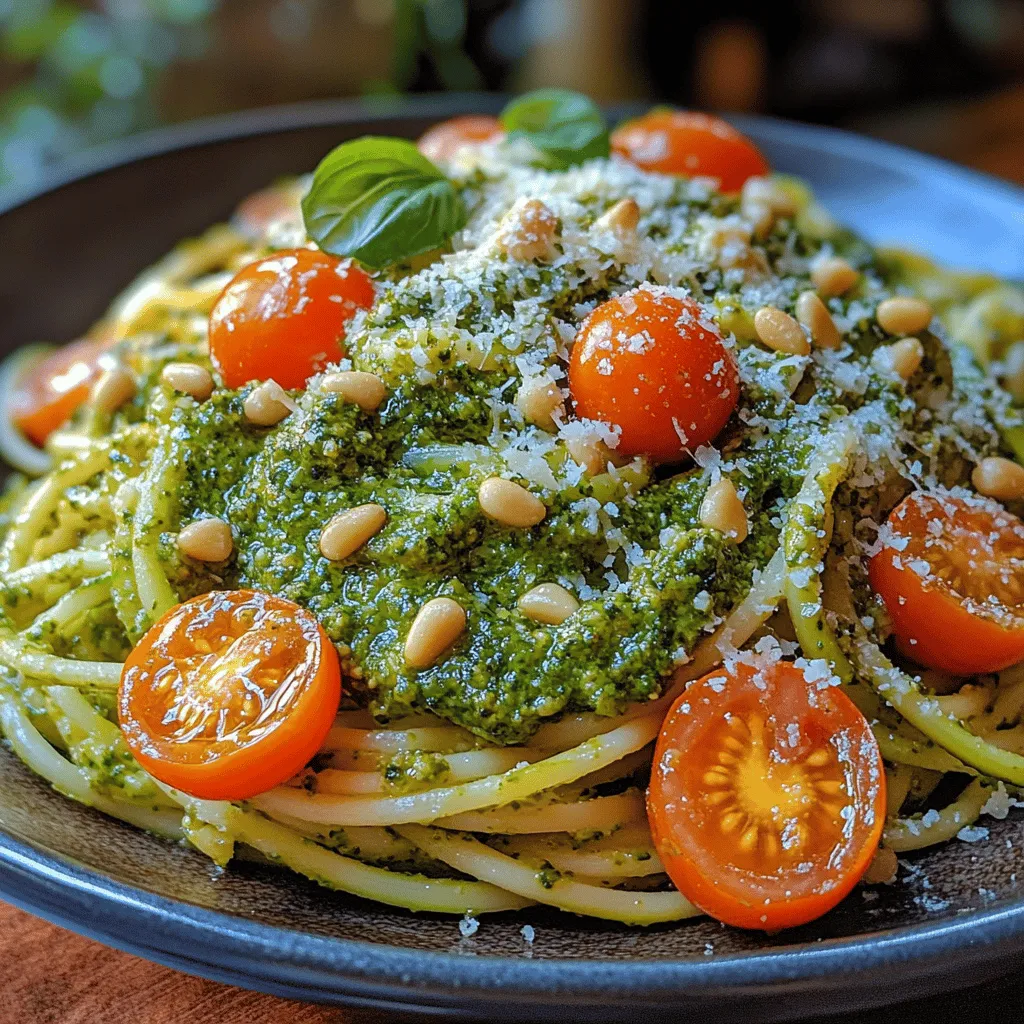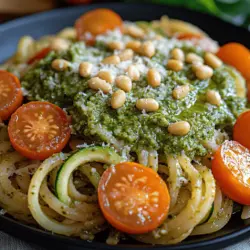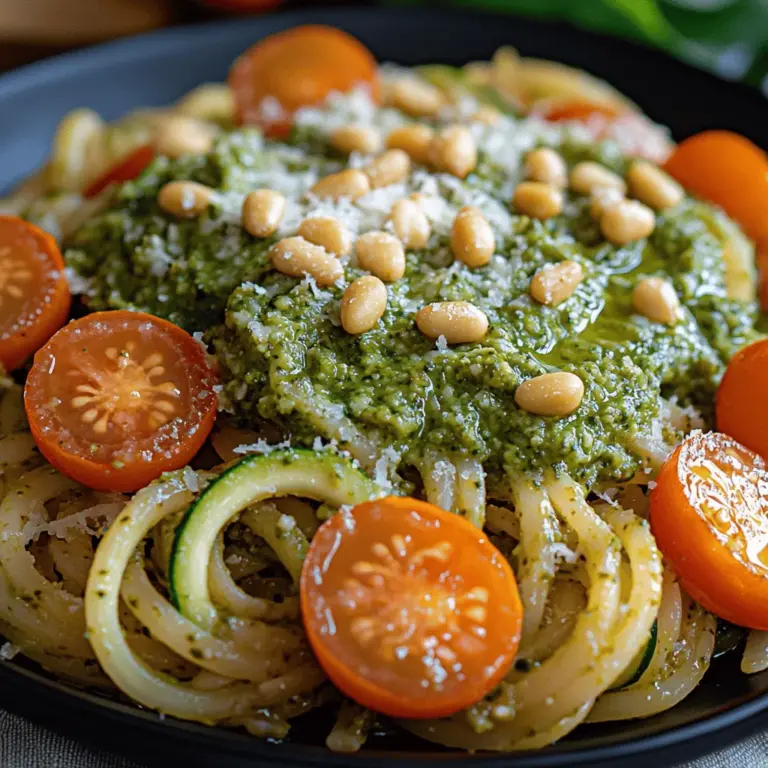Zucchini Basil Pesto Pasta: A Fresh and Healthy Delight
Zucchini Basil Pesto Pasta is a vibrant and delicious dish that perfectly captures the essence of summer dining. With its fresh flavors and healthful ingredients, this pasta dish stands out not only for its taste but also for its nutritional benefits. Whether you’re a pasta lover or someone who prioritizes healthy eating, this recipe offers a delightful balance that satisfies both cravings and dietary goals.
At the heart of this dish is the combination of tender zucchini and aromatic basil, both of which contribute to a meal that is not only visually appealing but also packed with essential nutrients. Zucchini, a star ingredient in this recipe, brings a unique texture and a subtle flavor that complements the robust, herbaceous notes of the basil pesto. This dish is perfect for a light summer dinner or a quick weeknight meal, making it a versatile addition to your culinary repertoire.
The Appeal of Zucchini in Pasta Dishes
Incorporating zucchini into pasta dishes is a fantastic way to enhance both the nutritional value and the overall flavor of your meal. This versatile vegetable is not just a trendy ingredient; it offers numerous health benefits that make it a worthy addition to your diet.
Nutritional Benefits of Zucchini
Zucchini is low in calories, making it an excellent choice for those looking to maintain or lose weight. In fact, a medium-sized zucchini contains only about 33 calories, making it a guilt-free way to enjoy a satisfying meal. Additionally, zucchini is high in vitamins and minerals, particularly vitamin C, vitamin A, and potassium, which are critical for overall health.
One of the standout features of zucchini is its high water content, which can help keep you hydrated, especially during the warmer months. Furthermore, zucchini is rich in dietary fiber, which aids in digestion and promotes a feeling of fullness. This combination of low calories and high fiber makes zucchini an ideal ingredient for anyone looking to eat healthier without sacrificing flavor.
Creative Uses of Zucchini in Cooking
Zucchini’s versatility means it can be prepared in various ways, adding texture and taste to a multitude of dishes. In the context of pasta, zucchini can be spiralized into noodles, creating a lighter alternative to traditional pasta. This method not only lowers the carbohydrate content of the dish but also adds a fun twist to your presentation.
Alternatively, diced zucchini can be sautéed or roasted and tossed into your pasta for a more substantial bite. The choice between spiralizing and dicing often comes down to personal preference; spiralized zucchini noodles provide a unique texture, while diced zucchini offers a hearty addition to each forkful. Regardless of how you choose to prepare it, zucchini enhances the overall flavor profile of the dish, making it more complex and enjoyable.
Basil: The Heart of the Pesto
No pesto is complete without basil, and in this recipe, it takes center stage. The fresh, aromatic qualities of basil play a crucial role in defining the dish’s flavor, making it a beloved herb among chefs and home cooks alike.
Nutritional and Health Benefits of Basil
Basil is more than just a flavorful herb; it is also packed with health benefits. Rich in antioxidants, basil contains compounds that help combat oxidative stress in the body. Additionally, it has anti-inflammatory properties that can contribute to overall wellness. Incorporating basil into your meals not only elevates the taste but also adds a healthful component that supports your immune system.
The Role of Fresh Herbs in Cooking
Fresh herbs like basil do more than just provide flavor; they also add aroma and vibrancy to dishes. The impact of using fresh basil compared to dried herbs is significant; fresh basil offers a bright, peppery flavor that can transform a simple dish into something extraordinary. The essential oils released from fresh basil enhance the overall sensory experience of the meal, making each bite more enjoyable.
When preparing your Zucchini Basil Pesto Pasta, using fresh basil will make all the difference in achieving that authentic pesto taste. For the best results, choose basil leaves that are vibrant in color and free from blemishes.
Ingredients Breakdown
To create the perfect Zucchini Basil Pesto Pasta, selecting the right ingredients is crucial. Here’s a closer look at each component of the dish:
Zucchini: Selection Tips and Nutritional Information
When choosing zucchini, look for firm, unblemished specimens with a glossy skin. Smaller zucchinis tend to be more tender and flavorful, while larger zucchinis can be more fibrous and watery. For optimal freshness, store zucchini in the refrigerator and use it within a few days of purchase.
In addition to its numerous health benefits, zucchini is incredibly versatile in the kitchen. It can be used in a variety of dishes, from ratatouille to fritters, proving that it is an ingredient that can shine in many culinary contexts.
Fresh Basil: How to Choose and Store for Maximum Freshness
For the best flavor, select fresh basil with vibrant green leaves and a fragrant aroma. Avoid any leaves that appear wilted or discolored. To maximize freshness, store basil in a glass of water at room temperature or wrap it in a damp paper towel and place it in a plastic bag in the refrigerator. This will help prolong its shelf life and maintain its potent flavor for your pesto.
Pine Nuts: Nutritional Value and Toasting Tips
Pine nuts are a key ingredient in traditional pesto, adding a rich, buttery flavor and a dose of healthy fats. They are an excellent source of protein, magnesium, and vitamin E, making them a nutritious addition to the dish. To enhance their flavor, consider toasting pine nuts in a dry skillet over medium heat for a few minutes until they are golden brown and fragrant. This simple step brings out their natural oils and elevates the overall taste of your pesto.
—
As you prepare to create your Zucchini Basil Pesto Pasta, remember that the quality of your ingredients will significantly impact the final result. Embrace the freshness of summer produce and enjoy the process of crafting a dish that is not only delicious but also nourishing. In the following sections, we will delve into the step-by-step instructions for making this delightful recipe, ensuring you achieve a pasta dish that will impress family and friends alike.

Parmesan Cheese: The Importance of Using Fresh Grated Cheese
When it comes to preparing Zucchini Basil Pesto Pasta, the quality of your ingredients can make all the difference. One standout ingredient is Parmesan cheese. Opting for freshly grated Parmesan over pre-packaged varieties not only enhances the flavor but also contributes a creamier texture to the pesto. Freshly grated cheese melts beautifully into the warm pasta, allowing it to cling better to each strand, ensuring every bite is full of rich, cheesy goodness.
Parmesan cheese is also packed with nutrients. It is a good source of calcium and protein, which are essential for bone health and muscle repair. Its umami flavor boosts the overall profile of the dish, making it more satisfying and delicious.
Garlic: Health Benefits and Flavor Contributions
Garlic serves as another key ingredient in this recipe, adding depth and pungency to the pesto. Beyond its robust flavor, garlic is renowned for its numerous health benefits. It possesses anti-inflammatory and antioxidant properties, which can help bolster the immune system. Additionally, garlic is known to support cardiovascular health by reducing blood pressure and cholesterol levels.
Incorporating garlic into your Zucchini Basil Pesto Pasta not only enhances the dish’s taste but also contributes to your overall wellness. When blended into the pesto, it mellows out slightly, allowing its flavor to integrate seamlessly into the sauce.
Extra Virgin Olive Oil: Benefits of Using High-Quality Olive Oil
Extra virgin olive oil is a staple in Mediterranean cooking and for good reason. Using high-quality extra virgin olive oil in your pesto not only elevates the flavor but also provides a wealth of health benefits. It is rich in monounsaturated fats, which may help reduce inflammation and lower the risk of chronic diseases.
The oil’s fruity, peppery notes complement the fresh basil and zucchini, creating a harmonious balance in the pesto. When emulsified with the other ingredients, it creates a silky-smooth sauce that clings to the pasta beautifully. Look for cold-pressed, organic extra virgin olive oil for the best flavor and health benefits.
Optional Ingredients: Benefits of Cherry Tomatoes as Garnish
While the core of Zucchini Basil Pesto Pasta is simple yet flavorful, garnishing your dish with cherry tomatoes can elevate it to new heights. These little bursts of sweetness add a delightful contrast to the savory pesto, enhancing both the visual appeal and taste of the dish.
Cherry tomatoes are not just for decoration; they are rich in vitamins C and K, as well as antioxidants like lycopene, which can promote heart health. Sautéing them briefly before serving can intensify their sweetness and add a juicy element to the dish.
Step-by-Step Instructions for Zucchini Basil Pesto Pasta
Cooking the Pasta: Tips for Achieving the Perfect Al Dente Texture
1. Choose Your Pasta: Select your preferred type of pasta. Whole grain and gluten-free options work well, providing a nutritious base.
2. Boil Water: Fill a large pot with water, add a generous pinch of salt, and bring it to a rolling boil. The salt is crucial as it enhances the flavor of the pasta.
3. Cook the Pasta: Add the pasta to the boiling water and follow the package instructions for cooking time. Aim for al dente, which means the pasta should be firm to the bite. This usually takes 1-2 minutes less than the package suggests.
4. Reserve Pasta Water: Before draining, reserve about a cup of the pasta cooking water. This starchy water will help create the perfect consistency for your pesto sauce.
Preparing the Pesto: A Deeper Look into the Emulsification Process
1. Gather Ingredients: In a food processor, combine fresh basil leaves, pine nuts, garlic, and a pinch of salt.
2. Pulse to Combine: Process the mixture in short bursts until finely chopped.
3. Add Parmesan: Gradually add the freshly grated Parmesan cheese while continuing to pulse.
4. Emulsify with Olive Oil: With the food processor running, slowly drizzle in the extra virgin olive oil until the mixture is smooth and creamy. The emulsification process is vital as it ensures the oil blends well with the other ingredients, creating a cohesive sauce.
Consistency Adjustments Using Reserved Pasta Water
After preparing your pesto, it may be thicker than desired. To achieve the perfect consistency, add a few tablespoons of the reserved pasta water gradually while blending until you reach your preferred thickness. The starchy water not only thins the pesto but also helps it adhere better to the pasta.
Combining Ingredients: Techniques for Evenly Distributing the Pesto
1. Combine Pasta and Pesto: In a large mixing bowl, add the drained pasta while it’s still warm. This warmth helps to activate the flavors in the pesto.
2. Toss to Combine: Add the prepared pesto to the pasta. Use tongs or a spatula to gently toss the pasta with the pesto, ensuring each strand is well coated.
3. Adjust Seasoning: Taste and adjust the seasoning if necessary, adding more salt or pepper to your liking.
Serving Suggestions: Ideas for Garnishing and Presentation
1. Plate the Dish: Serve the pasta in bowls or on plates, creating a lovely nest of noodles in the center.
2. Garnish with Cherry Tomatoes: Add halved cherry tomatoes on top for a pop of color and flavor.
3. Drizzle with Olive Oil: A light drizzle of extra virgin olive oil over the top can enhance the dish’s richness.
4. Fresh Basil Leaves: For an extra touch, garnish with a few fresh basil leaves or a sprinkle of additional Parmesan cheese.
Nutritional Information and Serving Size
Caloric Content and Macro Breakdown Per Serving
This Zucchini Basil Pesto Pasta recipe serves approximately four people. The nutritional breakdown per serving is as follows:
– Calories: 400
– Protein: 15g
– Carbohydrates: 50g
– Fat: 20g
– Fiber: 5g
These values can vary based on the specific ingredients used, such as the type of pasta and the amount of cheese.
Health Benefits of Whole Grain or Gluten-Free Pasta Options
Choosing whole grain pasta increases the fiber content of the dish, aiding digestion and promoting satiety. Alternatively, gluten-free pasta options made from quinoa or brown rice are excellent for those with gluten sensitivities while still providing a hearty meal.
Vegan Variations: Substitutions for Cheese and Nuts
For a vegan version, substitute Parmesan cheese with nutritional yeast, which offers a cheesy flavor without dairy. Use sunflower seeds or walnuts in place of pine nuts if you are looking for nut-free alternatives.
The Versatility of Zucchini Basil Pesto Pasta
Protein Additions: Suggestions for Adding Chicken, Shrimp, or Tofu
This dish is highly versatile and can be customized to include protein sources. Grilled chicken or shrimp can add a savory depth, while tofu provides a plant-based option. Simply cook your protein of choice and toss it with the pasta and pesto for a heartier meal.
Seasonal Variations: Incorporating Other Vegetables Based on Availability
Experiment with seasonal vegetables to keep the dish fresh and exciting. Peas, asparagus, or spinach can be excellent additions, contributing both flavor and nutrition. Stir them into the pasta during the last few minutes of cooking to achieve optimal tenderness.
Meal Prep Potential: How to Store and Reheat Leftovers Without Losing Flavor
Zucchini Basil Pesto Pasta can be made ahead and stored in the refrigerator for up to three days. To reheat, add a splash of reserved pasta water and warm it gently in a skillet over low heat. This method revives the flavors and maintains the pesto’s creamy texture.
Conclusion
Zucchini Basil Pesto Pasta is a delightful, vibrant dish that celebrates simple, fresh ingredients. Its health benefits, versatility, and rich flavors make it a perfect choice for weeknight dinners or special occasions alike. Whether you enjoy it as a vegetarian meal or personalize it with proteins and seasonal vegetables, this recipe invites creativity and experimentation in the kitchen.
We encourage you to try making this dish, allowing the flavors of basil, garlic, and Parmesan to shine through. Celebrate the joy of home cooking by making Zucchini Basil Pesto Pasta your own, exploring new ingredients, and sharing it with loved ones for a delicious dining experience.

